NRS 490: Reducing Re-hospitalization Rates in Home Healthcare
VerifiedAdded on 2023/06/09
|11
|2675
|104
Report
AI Summary
This report addresses the issue of rising re-hospitalization rates among home healthcare patients, particularly those with Chronic Obstructive Pulmonary Disease (COPD). It explores the lack of a standard treatment method and focuses on interventions like palliative care and oxygen therapy to manage symptoms and prevent exacerbations. The report includes a PICOT analysis, a literature review highlighting the importance of patient education and follow-up care, and a proposed implementation plan involving patient seminars and close monitoring of high-risk patients. Potential barriers to implementation, such as management reluctance and cost concerns, are identified, along with strategies to overcome them. The goal is to improve patient outcomes, reduce re-hospitalization rates, and enhance the quality of healthcare provided to COPD patients in home settings. Desklib provides access to similar assignments and study resources for students.
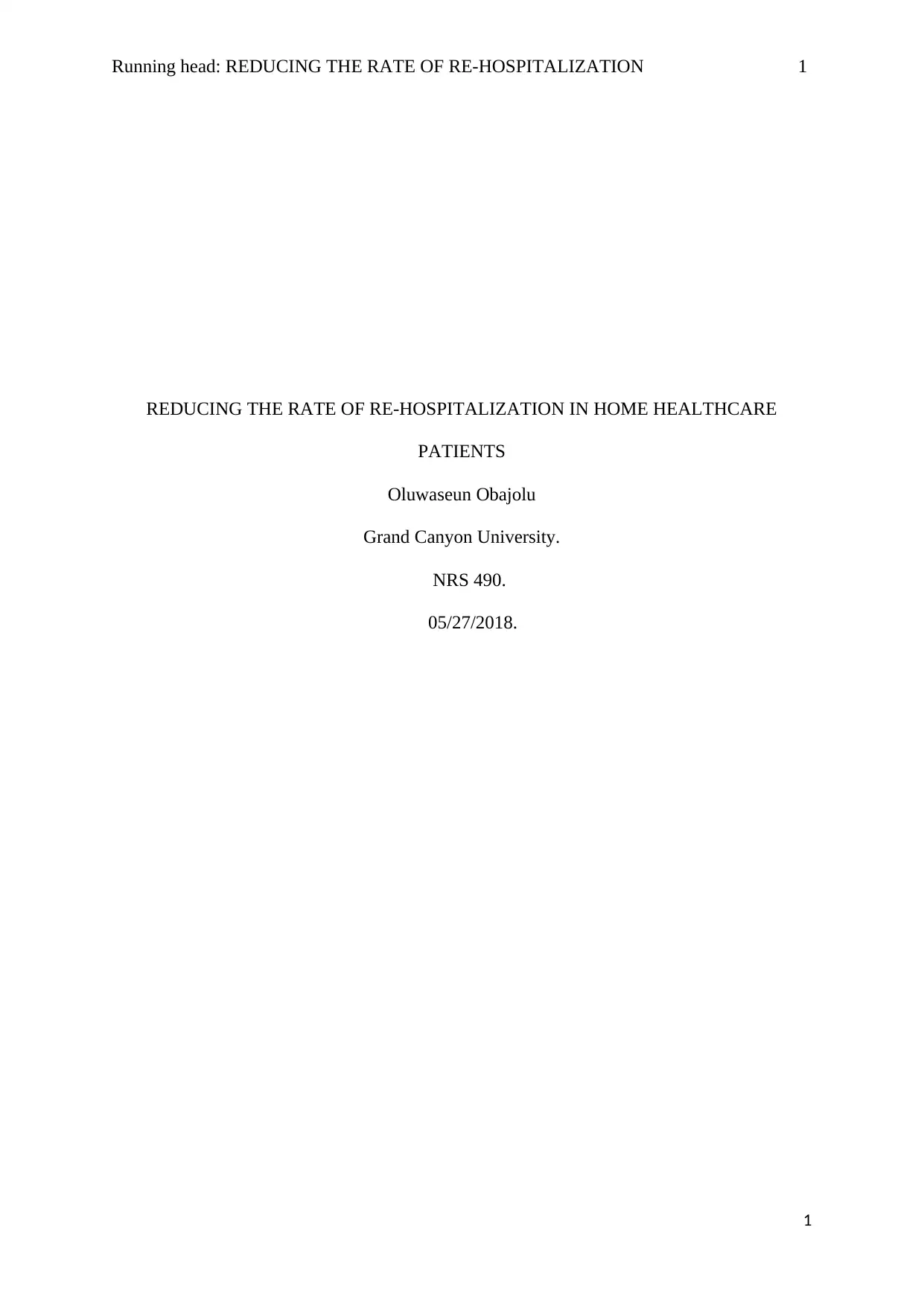
Running head: REDUCING THE RATE OF RE-HOSPITALIZATION 1
REDUCING THE RATE OF RE-HOSPITALIZATION IN HOME HEALTHCARE
PATIENTS
Oluwaseun Obajolu
Grand Canyon University.
NRS 490.
05/27/2018.
1
REDUCING THE RATE OF RE-HOSPITALIZATION IN HOME HEALTHCARE
PATIENTS
Oluwaseun Obajolu
Grand Canyon University.
NRS 490.
05/27/2018.
1
Paraphrase This Document
Need a fresh take? Get an instant paraphrase of this document with our AI Paraphraser
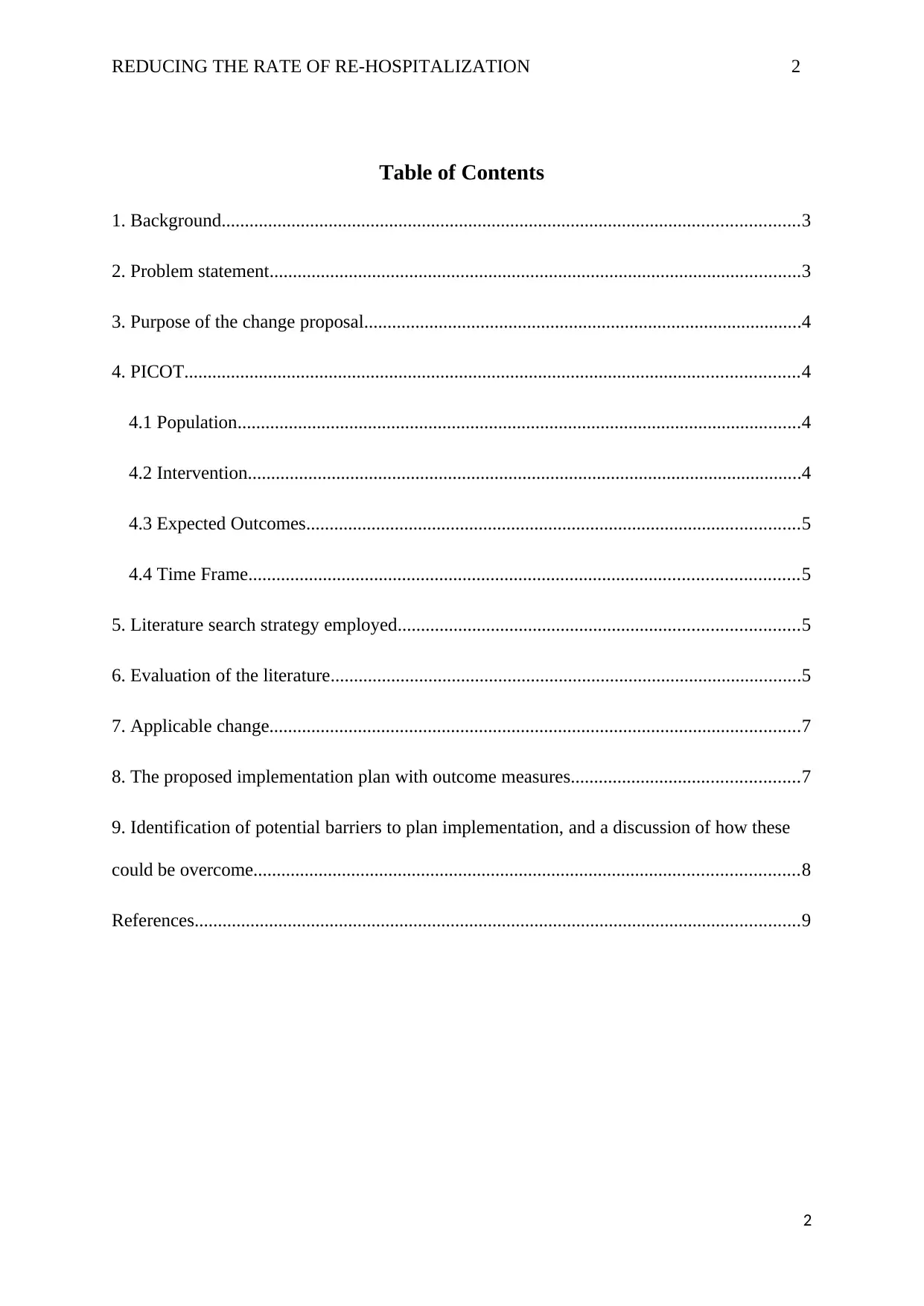
REDUCING THE RATE OF RE-HOSPITALIZATION 2
Table of Contents
1. Background............................................................................................................................3
2. Problem statement..................................................................................................................3
3. Purpose of the change proposal..............................................................................................4
4. PICOT....................................................................................................................................4
4.1 Population.........................................................................................................................4
4.2 Intervention.......................................................................................................................4
4.3 Expected Outcomes..........................................................................................................5
4.4 Time Frame......................................................................................................................5
5. Literature search strategy employed......................................................................................5
6. Evaluation of the literature.....................................................................................................5
7. Applicable change..................................................................................................................7
8. The proposed implementation plan with outcome measures.................................................7
9. Identification of potential barriers to plan implementation, and a discussion of how these
could be overcome.....................................................................................................................8
References..................................................................................................................................9
2
Table of Contents
1. Background............................................................................................................................3
2. Problem statement..................................................................................................................3
3. Purpose of the change proposal..............................................................................................4
4. PICOT....................................................................................................................................4
4.1 Population.........................................................................................................................4
4.2 Intervention.......................................................................................................................4
4.3 Expected Outcomes..........................................................................................................5
4.4 Time Frame......................................................................................................................5
5. Literature search strategy employed......................................................................................5
6. Evaluation of the literature.....................................................................................................5
7. Applicable change..................................................................................................................7
8. The proposed implementation plan with outcome measures.................................................7
9. Identification of potential barriers to plan implementation, and a discussion of how these
could be overcome.....................................................................................................................8
References..................................................................................................................................9
2
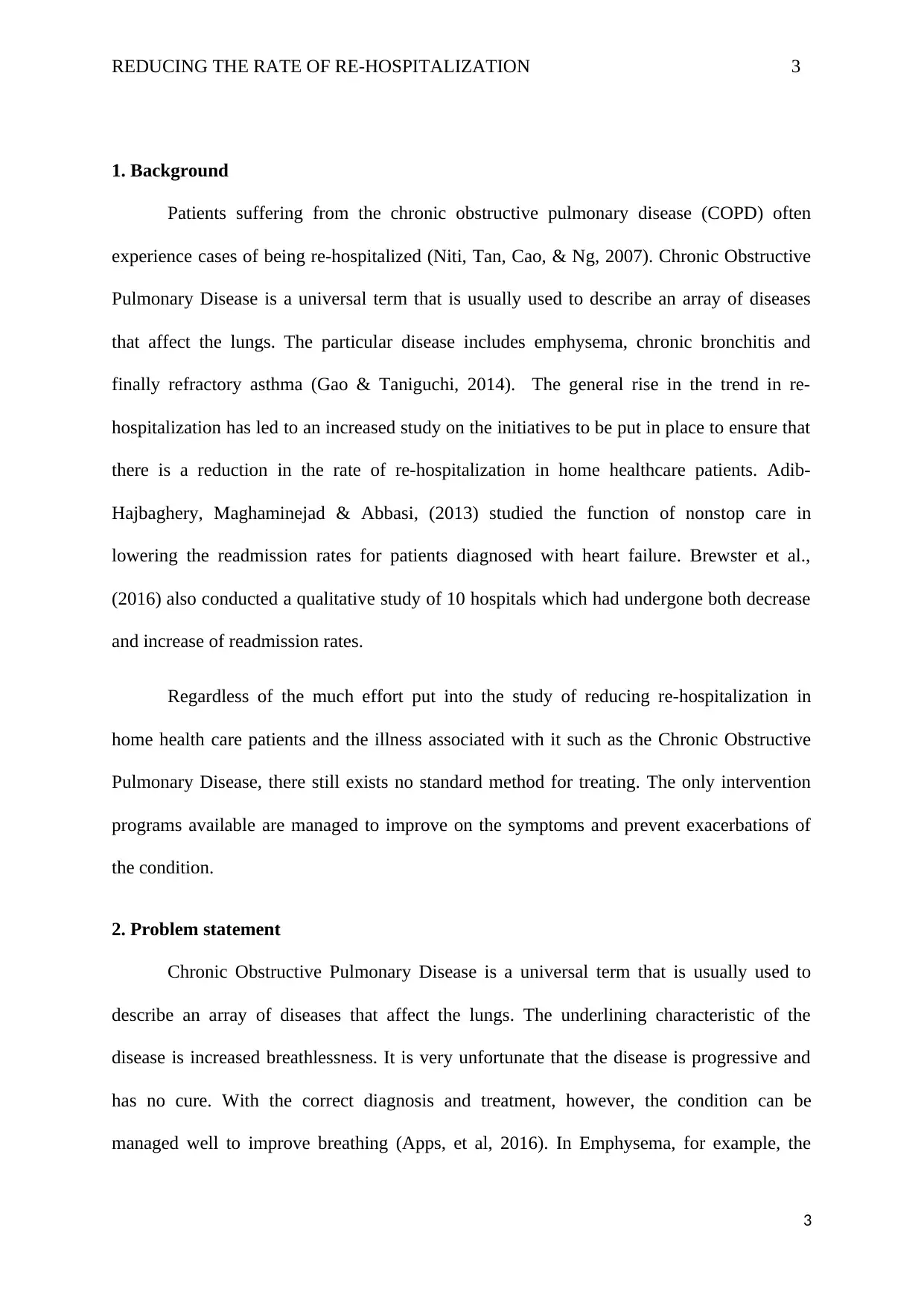
REDUCING THE RATE OF RE-HOSPITALIZATION 3
1. Background
Patients suffering from the chronic obstructive pulmonary disease (COPD) often
experience cases of being re-hospitalized (Niti, Tan, Cao, & Ng, 2007). Chronic Obstructive
Pulmonary Disease is a universal term that is usually used to describe an array of diseases
that affect the lungs. The particular disease includes emphysema, chronic bronchitis and
finally refractory asthma (Gao & Taniguchi, 2014). The general rise in the trend in re-
hospitalization has led to an increased study on the initiatives to be put in place to ensure that
there is a reduction in the rate of re-hospitalization in home healthcare patients. Adib-
Hajbaghery, Maghaminejad & Abbasi, (2013) studied the function of nonstop care in
lowering the readmission rates for patients diagnosed with heart failure. Brewster et al.,
(2016) also conducted a qualitative study of 10 hospitals which had undergone both decrease
and increase of readmission rates.
Regardless of the much effort put into the study of reducing re-hospitalization in
home health care patients and the illness associated with it such as the Chronic Obstructive
Pulmonary Disease, there still exists no standard method for treating. The only intervention
programs available are managed to improve on the symptoms and prevent exacerbations of
the condition.
2. Problem statement
Chronic Obstructive Pulmonary Disease is a universal term that is usually used to
describe an array of diseases that affect the lungs. The underlining characteristic of the
disease is increased breathlessness. It is very unfortunate that the disease is progressive and
has no cure. With the correct diagnosis and treatment, however, the condition can be
managed well to improve breathing (Apps, et al, 2016). In Emphysema, for example, the
3
1. Background
Patients suffering from the chronic obstructive pulmonary disease (COPD) often
experience cases of being re-hospitalized (Niti, Tan, Cao, & Ng, 2007). Chronic Obstructive
Pulmonary Disease is a universal term that is usually used to describe an array of diseases
that affect the lungs. The particular disease includes emphysema, chronic bronchitis and
finally refractory asthma (Gao & Taniguchi, 2014). The general rise in the trend in re-
hospitalization has led to an increased study on the initiatives to be put in place to ensure that
there is a reduction in the rate of re-hospitalization in home healthcare patients. Adib-
Hajbaghery, Maghaminejad & Abbasi, (2013) studied the function of nonstop care in
lowering the readmission rates for patients diagnosed with heart failure. Brewster et al.,
(2016) also conducted a qualitative study of 10 hospitals which had undergone both decrease
and increase of readmission rates.
Regardless of the much effort put into the study of reducing re-hospitalization in
home health care patients and the illness associated with it such as the Chronic Obstructive
Pulmonary Disease, there still exists no standard method for treating. The only intervention
programs available are managed to improve on the symptoms and prevent exacerbations of
the condition.
2. Problem statement
Chronic Obstructive Pulmonary Disease is a universal term that is usually used to
describe an array of diseases that affect the lungs. The underlining characteristic of the
disease is increased breathlessness. It is very unfortunate that the disease is progressive and
has no cure. With the correct diagnosis and treatment, however, the condition can be
managed well to improve breathing (Apps, et al, 2016). In Emphysema, for example, the
3
⊘ This is a preview!⊘
Do you want full access?
Subscribe today to unlock all pages.

Trusted by 1+ million students worldwide
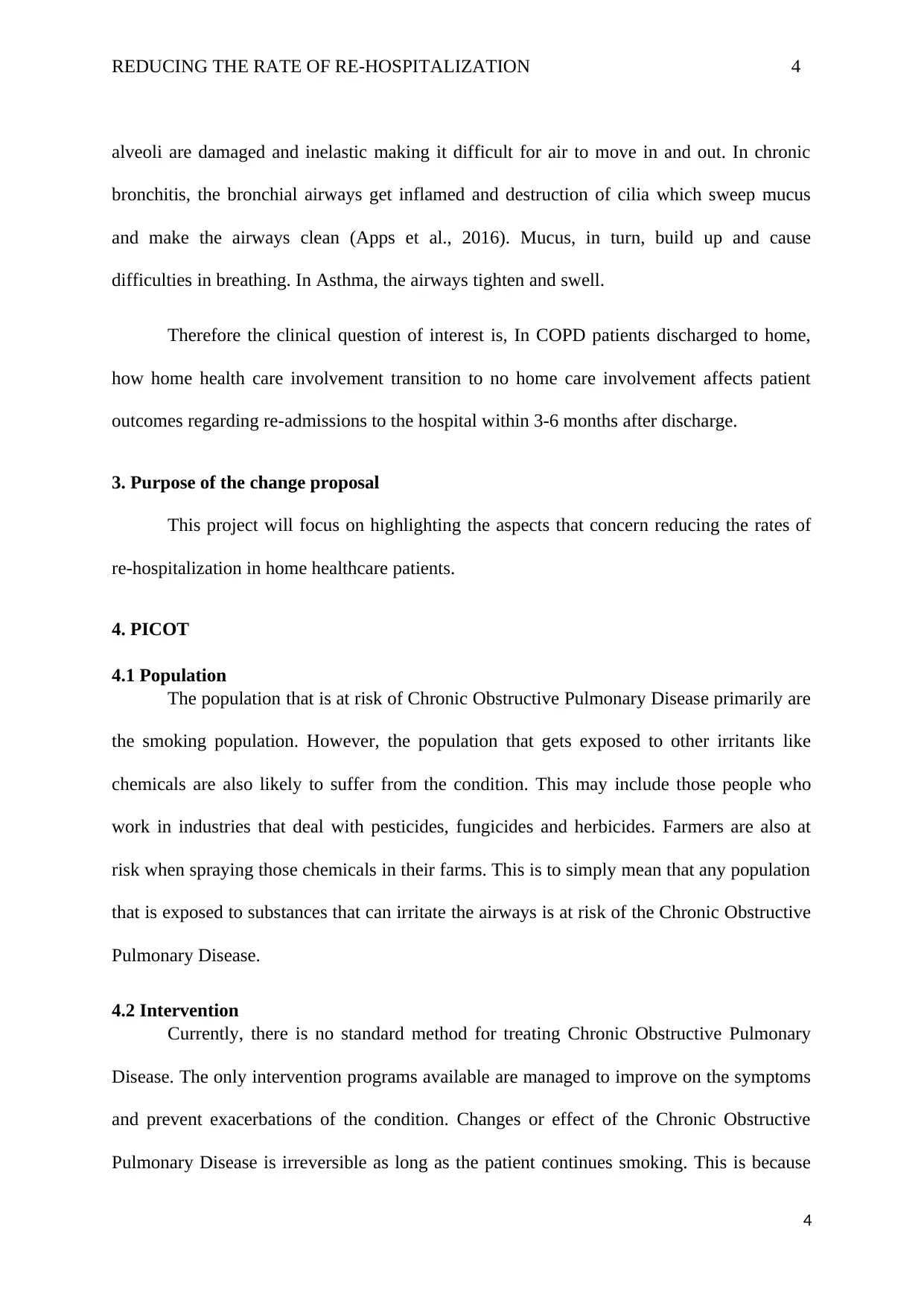
REDUCING THE RATE OF RE-HOSPITALIZATION 4
alveoli are damaged and inelastic making it difficult for air to move in and out. In chronic
bronchitis, the bronchial airways get inflamed and destruction of cilia which sweep mucus
and make the airways clean (Apps et al., 2016). Mucus, in turn, build up and cause
difficulties in breathing. In Asthma, the airways tighten and swell.
Therefore the clinical question of interest is, In COPD patients discharged to home,
how home health care involvement transition to no home care involvement affects patient
outcomes regarding re-admissions to the hospital within 3-6 months after discharge.
3. Purpose of the change proposal
This project will focus on highlighting the aspects that concern reducing the rates of
re-hospitalization in home healthcare patients.
4. PICOT
4.1 Population
The population that is at risk of Chronic Obstructive Pulmonary Disease primarily are
the smoking population. However, the population that gets exposed to other irritants like
chemicals are also likely to suffer from the condition. This may include those people who
work in industries that deal with pesticides, fungicides and herbicides. Farmers are also at
risk when spraying those chemicals in their farms. This is to simply mean that any population
that is exposed to substances that can irritate the airways is at risk of the Chronic Obstructive
Pulmonary Disease.
4.2 Intervention
Currently, there is no standard method for treating Chronic Obstructive Pulmonary
Disease. The only intervention programs available are managed to improve on the symptoms
and prevent exacerbations of the condition. Changes or effect of the Chronic Obstructive
Pulmonary Disease is irreversible as long as the patient continues smoking. This is because
4
alveoli are damaged and inelastic making it difficult for air to move in and out. In chronic
bronchitis, the bronchial airways get inflamed and destruction of cilia which sweep mucus
and make the airways clean (Apps et al., 2016). Mucus, in turn, build up and cause
difficulties in breathing. In Asthma, the airways tighten and swell.
Therefore the clinical question of interest is, In COPD patients discharged to home,
how home health care involvement transition to no home care involvement affects patient
outcomes regarding re-admissions to the hospital within 3-6 months after discharge.
3. Purpose of the change proposal
This project will focus on highlighting the aspects that concern reducing the rates of
re-hospitalization in home healthcare patients.
4. PICOT
4.1 Population
The population that is at risk of Chronic Obstructive Pulmonary Disease primarily are
the smoking population. However, the population that gets exposed to other irritants like
chemicals are also likely to suffer from the condition. This may include those people who
work in industries that deal with pesticides, fungicides and herbicides. Farmers are also at
risk when spraying those chemicals in their farms. This is to simply mean that any population
that is exposed to substances that can irritate the airways is at risk of the Chronic Obstructive
Pulmonary Disease.
4.2 Intervention
Currently, there is no standard method for treating Chronic Obstructive Pulmonary
Disease. The only intervention programs available are managed to improve on the symptoms
and prevent exacerbations of the condition. Changes or effect of the Chronic Obstructive
Pulmonary Disease is irreversible as long as the patient continues smoking. This is because
4
Paraphrase This Document
Need a fresh take? Get an instant paraphrase of this document with our AI Paraphraser

REDUCING THE RATE OF RE-HOSPITALIZATION 5
the condition causes a merging of alveoli to form inelastic sacs which subsequently reduce
the surface area of the alveolar membrane leading to impaired gaseous exchange (Pascoe et
al., 2015).
The best interventions that can be utilized are palliative care and oxygen therapy
(Lange et al., 2015). Palliative care is a form of service offered to individuals with life-
threatening conditions and Chronic Obstructive Pulmonary Disease is among them. Chronic
Obstructive Pulmonary Disease is regarded as one of the terminal illnesses that only need
palliative care. The Chronic Obstructive Pulmonary disease results in the destruction of the
alveoli in the lungs rendering them ineffective when it comes to the ability to oxygenate the
blood. This, therefore, necessitates the supply of oxygen which is achieved through oxygen
therapy
4.3 Expected Outcomes
Since the effect or rather the damage that arises from the COPD is irreversible, the
only expected outcome is to prolong life devoid of frequent hospitalizations.
4.4 Time Frame
In the case of palliative care, there is no expected time of recovery rather the time it
takes for the patient to die. The intervention in this particular case, therefore, does not have
any definite time frame. However, the care has to be provided up to that time the patient will
die.
5. Literature search strategy employed
The study employed a critical analysis of relevant extant literature by first designing
research questions aimed at providing answers to the study topic. Databases such as Pubmed,
Google Scholar and Science Direct were used including keywords readmissions, heart failure,
home monitoring and follow-ups to draw relevant articles for analysis.
5
the condition causes a merging of alveoli to form inelastic sacs which subsequently reduce
the surface area of the alveolar membrane leading to impaired gaseous exchange (Pascoe et
al., 2015).
The best interventions that can be utilized are palliative care and oxygen therapy
(Lange et al., 2015). Palliative care is a form of service offered to individuals with life-
threatening conditions and Chronic Obstructive Pulmonary Disease is among them. Chronic
Obstructive Pulmonary Disease is regarded as one of the terminal illnesses that only need
palliative care. The Chronic Obstructive Pulmonary disease results in the destruction of the
alveoli in the lungs rendering them ineffective when it comes to the ability to oxygenate the
blood. This, therefore, necessitates the supply of oxygen which is achieved through oxygen
therapy
4.3 Expected Outcomes
Since the effect or rather the damage that arises from the COPD is irreversible, the
only expected outcome is to prolong life devoid of frequent hospitalizations.
4.4 Time Frame
In the case of palliative care, there is no expected time of recovery rather the time it
takes for the patient to die. The intervention in this particular case, therefore, does not have
any definite time frame. However, the care has to be provided up to that time the patient will
die.
5. Literature search strategy employed
The study employed a critical analysis of relevant extant literature by first designing
research questions aimed at providing answers to the study topic. Databases such as Pubmed,
Google Scholar and Science Direct were used including keywords readmissions, heart failure,
home monitoring and follow-ups to draw relevant articles for analysis.
5

REDUCING THE RATE OF RE-HOSPITALIZATION 6
6. Evaluation of the literature
Adib-Hajbaghery, Maghaminejad & Abbasi, (2013) aimed at investigating the
reduction in readmission rates through continuous care post heart failure using qualitative
study design (random sampling) and found out that patient education along with follow-ups
significantly improved the quality of care. This finding is supported by another study
conducted by Brewster et al., (2016) where they highlighted the fact that patient education
and effective follow-up after discharge has reduced hospital re-admissions ensuring
continuity of care by improving medical performance. This finding is not consistent with
another study conducted by Delbridge et al., (2016) as it was aimed at studying BCL-2
protein family and its role in cancer therapy and development.
However, another study conducted by Kripalani et al., (2014) supported the capstone
project that multiple interventions like patient education; outpatient follow-ups after
discharge have successfully reduced readmissions for patients who are discharged to home.
Another study conducted by Li et al., (2015) was aimed at exploring the transition care needs
before discharge to reduce mortality risk and readmissions after surgery. The authors found
out that the most senior patients had the highest transitional care needs (TCN) (49%) with
their major TCNs being rehabilitation services. Whereas, Martínez-Jiménez et al., (2017)
found out that formerly unknown mutations were possibly responsible for drug resistance.
On a contrary, Morrison, (2016) studied the outcomes of transitional care programs in
regards to self-management after discharge from the hospital with a significant reduction in
hospital re-admissions. He found out that patients under CNS intervention had substantial
lower ED visits and hospitalizations in the sixteen weeks of post-intervention than those
under intervention under the same time period. Nelson & Pulley, (2015) also examined the
6
6. Evaluation of the literature
Adib-Hajbaghery, Maghaminejad & Abbasi, (2013) aimed at investigating the
reduction in readmission rates through continuous care post heart failure using qualitative
study design (random sampling) and found out that patient education along with follow-ups
significantly improved the quality of care. This finding is supported by another study
conducted by Brewster et al., (2016) where they highlighted the fact that patient education
and effective follow-up after discharge has reduced hospital re-admissions ensuring
continuity of care by improving medical performance. This finding is not consistent with
another study conducted by Delbridge et al., (2016) as it was aimed at studying BCL-2
protein family and its role in cancer therapy and development.
However, another study conducted by Kripalani et al., (2014) supported the capstone
project that multiple interventions like patient education; outpatient follow-ups after
discharge have successfully reduced readmissions for patients who are discharged to home.
Another study conducted by Li et al., (2015) was aimed at exploring the transition care needs
before discharge to reduce mortality risk and readmissions after surgery. The authors found
out that the most senior patients had the highest transitional care needs (TCN) (49%) with
their major TCNs being rehabilitation services. Whereas, Martínez-Jiménez et al., (2017)
found out that formerly unknown mutations were possibly responsible for drug resistance.
On a contrary, Morrison, (2016) studied the outcomes of transitional care programs in
regards to self-management after discharge from the hospital with a significant reduction in
hospital re-admissions. He found out that patients under CNS intervention had substantial
lower ED visits and hospitalizations in the sixteen weeks of post-intervention than those
under intervention under the same time period. Nelson & Pulley, (2015) also examined the
6
⊘ This is a preview!⊘
Do you want full access?
Subscribe today to unlock all pages.

Trusted by 1+ million students worldwide
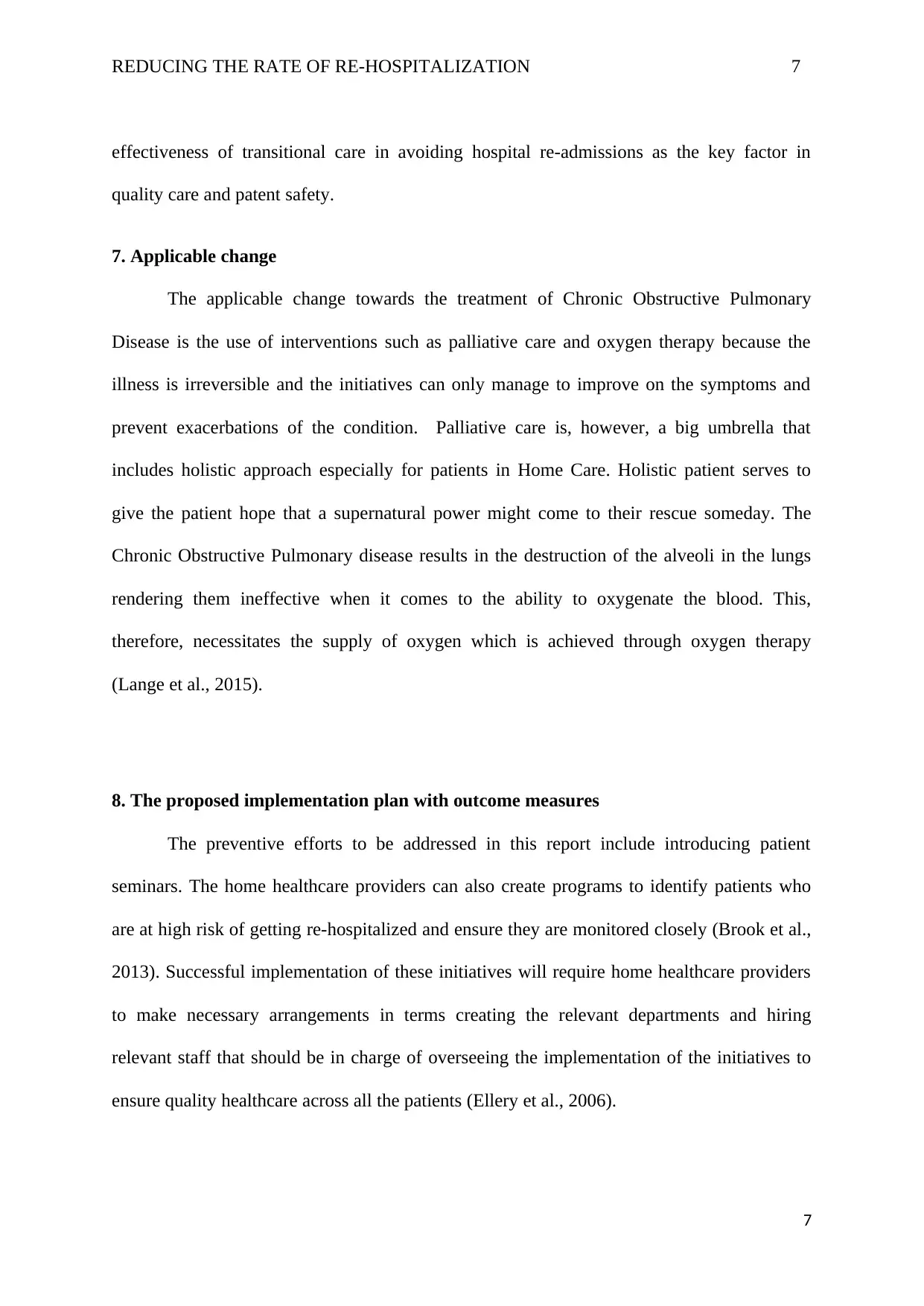
REDUCING THE RATE OF RE-HOSPITALIZATION 7
effectiveness of transitional care in avoiding hospital re-admissions as the key factor in
quality care and patent safety.
7. Applicable change
The applicable change towards the treatment of Chronic Obstructive Pulmonary
Disease is the use of interventions such as palliative care and oxygen therapy because the
illness is irreversible and the initiatives can only manage to improve on the symptoms and
prevent exacerbations of the condition. Palliative care is, however, a big umbrella that
includes holistic approach especially for patients in Home Care. Holistic patient serves to
give the patient hope that a supernatural power might come to their rescue someday. The
Chronic Obstructive Pulmonary disease results in the destruction of the alveoli in the lungs
rendering them ineffective when it comes to the ability to oxygenate the blood. This,
therefore, necessitates the supply of oxygen which is achieved through oxygen therapy
(Lange et al., 2015).
8. The proposed implementation plan with outcome measures
The preventive efforts to be addressed in this report include introducing patient
seminars. The home healthcare providers can also create programs to identify patients who
are at high risk of getting re-hospitalized and ensure they are monitored closely (Brook et al.,
2013). Successful implementation of these initiatives will require home healthcare providers
to make necessary arrangements in terms creating the relevant departments and hiring
relevant staff that should be in charge of overseeing the implementation of the initiatives to
ensure quality healthcare across all the patients (Ellery et al., 2006).
7
effectiveness of transitional care in avoiding hospital re-admissions as the key factor in
quality care and patent safety.
7. Applicable change
The applicable change towards the treatment of Chronic Obstructive Pulmonary
Disease is the use of interventions such as palliative care and oxygen therapy because the
illness is irreversible and the initiatives can only manage to improve on the symptoms and
prevent exacerbations of the condition. Palliative care is, however, a big umbrella that
includes holistic approach especially for patients in Home Care. Holistic patient serves to
give the patient hope that a supernatural power might come to their rescue someday. The
Chronic Obstructive Pulmonary disease results in the destruction of the alveoli in the lungs
rendering them ineffective when it comes to the ability to oxygenate the blood. This,
therefore, necessitates the supply of oxygen which is achieved through oxygen therapy
(Lange et al., 2015).
8. The proposed implementation plan with outcome measures
The preventive efforts to be addressed in this report include introducing patient
seminars. The home healthcare providers can also create programs to identify patients who
are at high risk of getting re-hospitalized and ensure they are monitored closely (Brook et al.,
2013). Successful implementation of these initiatives will require home healthcare providers
to make necessary arrangements in terms creating the relevant departments and hiring
relevant staff that should be in charge of overseeing the implementation of the initiatives to
ensure quality healthcare across all the patients (Ellery et al., 2006).
7
Paraphrase This Document
Need a fresh take? Get an instant paraphrase of this document with our AI Paraphraser
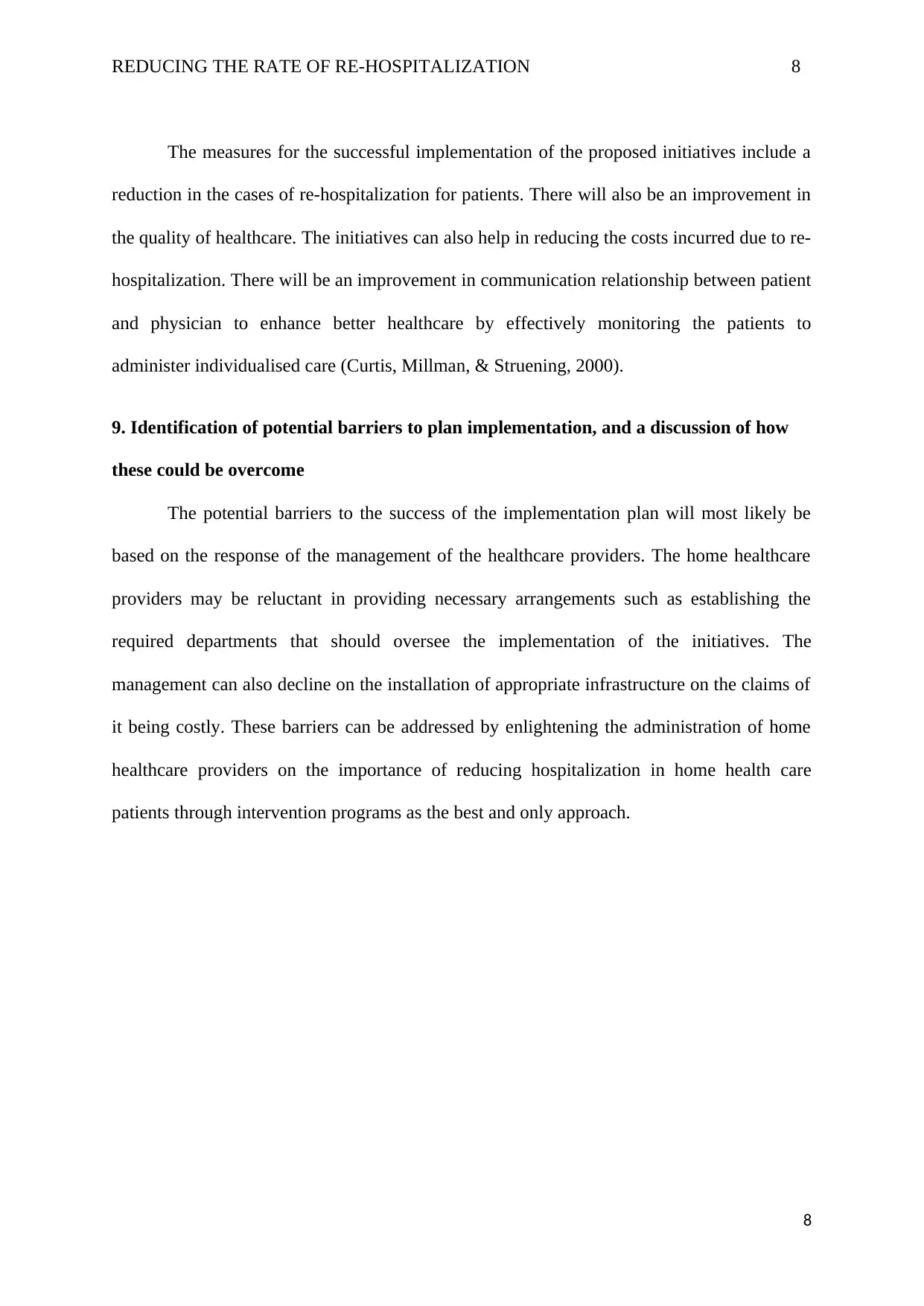
REDUCING THE RATE OF RE-HOSPITALIZATION 8
The measures for the successful implementation of the proposed initiatives include a
reduction in the cases of re-hospitalization for patients. There will also be an improvement in
the quality of healthcare. The initiatives can also help in reducing the costs incurred due to re-
hospitalization. There will be an improvement in communication relationship between patient
and physician to enhance better healthcare by effectively monitoring the patients to
administer individualised care (Curtis, Millman, & Struening, 2000).
9. Identification of potential barriers to plan implementation, and a discussion of how
these could be overcome
The potential barriers to the success of the implementation plan will most likely be
based on the response of the management of the healthcare providers. The home healthcare
providers may be reluctant in providing necessary arrangements such as establishing the
required departments that should oversee the implementation of the initiatives. The
management can also decline on the installation of appropriate infrastructure on the claims of
it being costly. These barriers can be addressed by enlightening the administration of home
healthcare providers on the importance of reducing hospitalization in home health care
patients through intervention programs as the best and only approach.
8
The measures for the successful implementation of the proposed initiatives include a
reduction in the cases of re-hospitalization for patients. There will also be an improvement in
the quality of healthcare. The initiatives can also help in reducing the costs incurred due to re-
hospitalization. There will be an improvement in communication relationship between patient
and physician to enhance better healthcare by effectively monitoring the patients to
administer individualised care (Curtis, Millman, & Struening, 2000).
9. Identification of potential barriers to plan implementation, and a discussion of how
these could be overcome
The potential barriers to the success of the implementation plan will most likely be
based on the response of the management of the healthcare providers. The home healthcare
providers may be reluctant in providing necessary arrangements such as establishing the
required departments that should oversee the implementation of the initiatives. The
management can also decline on the installation of appropriate infrastructure on the claims of
it being costly. These barriers can be addressed by enlightening the administration of home
healthcare providers on the importance of reducing hospitalization in home health care
patients through intervention programs as the best and only approach.
8

REDUCING THE RATE OF RE-HOSPITALIZATION 9
References
Adib-Hajbaghery, M., Maghaminejad, F., & Abbasi, A. (2013). The role of continuous care
in reducing readmission for patients with heart failure. Journal of caring
sciences, 2(4), 255.
Apps, M., Mukherjee, D., Abbas, S., Minter, J., & Whitfield, J. (2016). Integration of hospital
and community COPD services including pulmonary rehabilitation can improve
patient care and reduce hospital stays.
Brewster, A. L., Cherlin, E. J., Ndumele, C. D., Collins, D., Burgess, J. F., Charns, M. P., ...
& Curry, L. A. (2016). What Works in Readmissions Reduction. Medical care, 54(6),
600-607.
Brock, J., Mitchell, J., Irby, K., Stevens, B., Archibald, T., Goroski, A., & Lynn, J. (2013).
Association between quality improvement for care transitions in communities and
rehospitalizations among Medicare beneficiaries. Jama, 309(4), 381-391.
Curtis, J. L., Millman, E. J., Struening, E., & D'Ercole, A. (1992). Effect of case management
on rehospitalization and utilization of ambulatory care services. Psychiatric
Services, 43(9), 895-899.
Delbridge, A. R., Grabow, S., Strasser, A., & Vaux, D. L. (2016). Thirty years of BCL-2:
translating cell death discoveries into novel cancer therapies. Nature reviews
Cancer, 16(2), 99.
Ellery, S., Pakrashi, T., Paul, V., Sack, S., & Home CARE Phase 0 Study Investigators.
9
References
Adib-Hajbaghery, M., Maghaminejad, F., & Abbasi, A. (2013). The role of continuous care
in reducing readmission for patients with heart failure. Journal of caring
sciences, 2(4), 255.
Apps, M., Mukherjee, D., Abbas, S., Minter, J., & Whitfield, J. (2016). Integration of hospital
and community COPD services including pulmonary rehabilitation can improve
patient care and reduce hospital stays.
Brewster, A. L., Cherlin, E. J., Ndumele, C. D., Collins, D., Burgess, J. F., Charns, M. P., ...
& Curry, L. A. (2016). What Works in Readmissions Reduction. Medical care, 54(6),
600-607.
Brock, J., Mitchell, J., Irby, K., Stevens, B., Archibald, T., Goroski, A., & Lynn, J. (2013).
Association between quality improvement for care transitions in communities and
rehospitalizations among Medicare beneficiaries. Jama, 309(4), 381-391.
Curtis, J. L., Millman, E. J., Struening, E., & D'Ercole, A. (1992). Effect of case management
on rehospitalization and utilization of ambulatory care services. Psychiatric
Services, 43(9), 895-899.
Delbridge, A. R., Grabow, S., Strasser, A., & Vaux, D. L. (2016). Thirty years of BCL-2:
translating cell death discoveries into novel cancer therapies. Nature reviews
Cancer, 16(2), 99.
Ellery, S., Pakrashi, T., Paul, V., Sack, S., & Home CARE Phase 0 Study Investigators.
9
⊘ This is a preview!⊘
Do you want full access?
Subscribe today to unlock all pages.

Trusted by 1+ million students worldwide
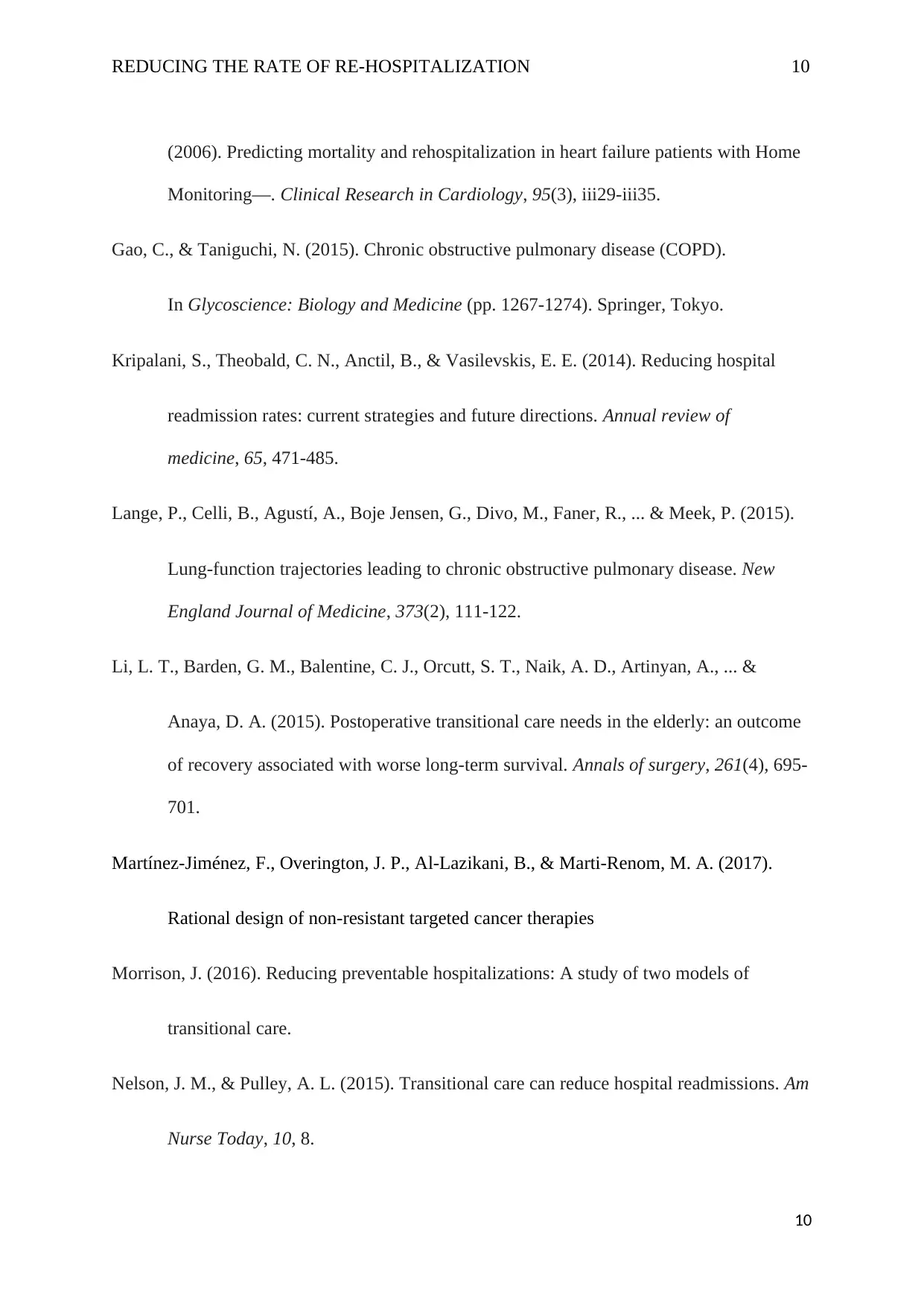
REDUCING THE RATE OF RE-HOSPITALIZATION 10
(2006). Predicting mortality and rehospitalization in heart failure patients with Home
Monitoring—. Clinical Research in Cardiology, 95(3), iii29-iii35.
Gao, C., & Taniguchi, N. (2015). Chronic obstructive pulmonary disease (COPD).
In Glycoscience: Biology and Medicine (pp. 1267-1274). Springer, Tokyo.
Kripalani, S., Theobald, C. N., Anctil, B., & Vasilevskis, E. E. (2014). Reducing hospital
readmission rates: current strategies and future directions. Annual review of
medicine, 65, 471-485.
Lange, P., Celli, B., Agustí, A., Boje Jensen, G., Divo, M., Faner, R., ... & Meek, P. (2015).
Lung-function trajectories leading to chronic obstructive pulmonary disease. New
England Journal of Medicine, 373(2), 111-122.
Li, L. T., Barden, G. M., Balentine, C. J., Orcutt, S. T., Naik, A. D., Artinyan, A., ... &
Anaya, D. A. (2015). Postoperative transitional care needs in the elderly: an outcome
of recovery associated with worse long-term survival. Annals of surgery, 261(4), 695-
701.
Martínez-Jiménez, F., Overington, J. P., Al-Lazikani, B., & Marti-Renom, M. A. (2017).
Rational design of non-resistant targeted cancer therapies
Morrison, J. (2016). Reducing preventable hospitalizations: A study of two models of
transitional care.
Nelson, J. M., & Pulley, A. L. (2015). Transitional care can reduce hospital readmissions. Am
Nurse Today, 10, 8.
10
(2006). Predicting mortality and rehospitalization in heart failure patients with Home
Monitoring—. Clinical Research in Cardiology, 95(3), iii29-iii35.
Gao, C., & Taniguchi, N. (2015). Chronic obstructive pulmonary disease (COPD).
In Glycoscience: Biology and Medicine (pp. 1267-1274). Springer, Tokyo.
Kripalani, S., Theobald, C. N., Anctil, B., & Vasilevskis, E. E. (2014). Reducing hospital
readmission rates: current strategies and future directions. Annual review of
medicine, 65, 471-485.
Lange, P., Celli, B., Agustí, A., Boje Jensen, G., Divo, M., Faner, R., ... & Meek, P. (2015).
Lung-function trajectories leading to chronic obstructive pulmonary disease. New
England Journal of Medicine, 373(2), 111-122.
Li, L. T., Barden, G. M., Balentine, C. J., Orcutt, S. T., Naik, A. D., Artinyan, A., ... &
Anaya, D. A. (2015). Postoperative transitional care needs in the elderly: an outcome
of recovery associated with worse long-term survival. Annals of surgery, 261(4), 695-
701.
Martínez-Jiménez, F., Overington, J. P., Al-Lazikani, B., & Marti-Renom, M. A. (2017).
Rational design of non-resistant targeted cancer therapies
Morrison, J. (2016). Reducing preventable hospitalizations: A study of two models of
transitional care.
Nelson, J. M., & Pulley, A. L. (2015). Transitional care can reduce hospital readmissions. Am
Nurse Today, 10, 8.
10
Paraphrase This Document
Need a fresh take? Get an instant paraphrase of this document with our AI Paraphraser
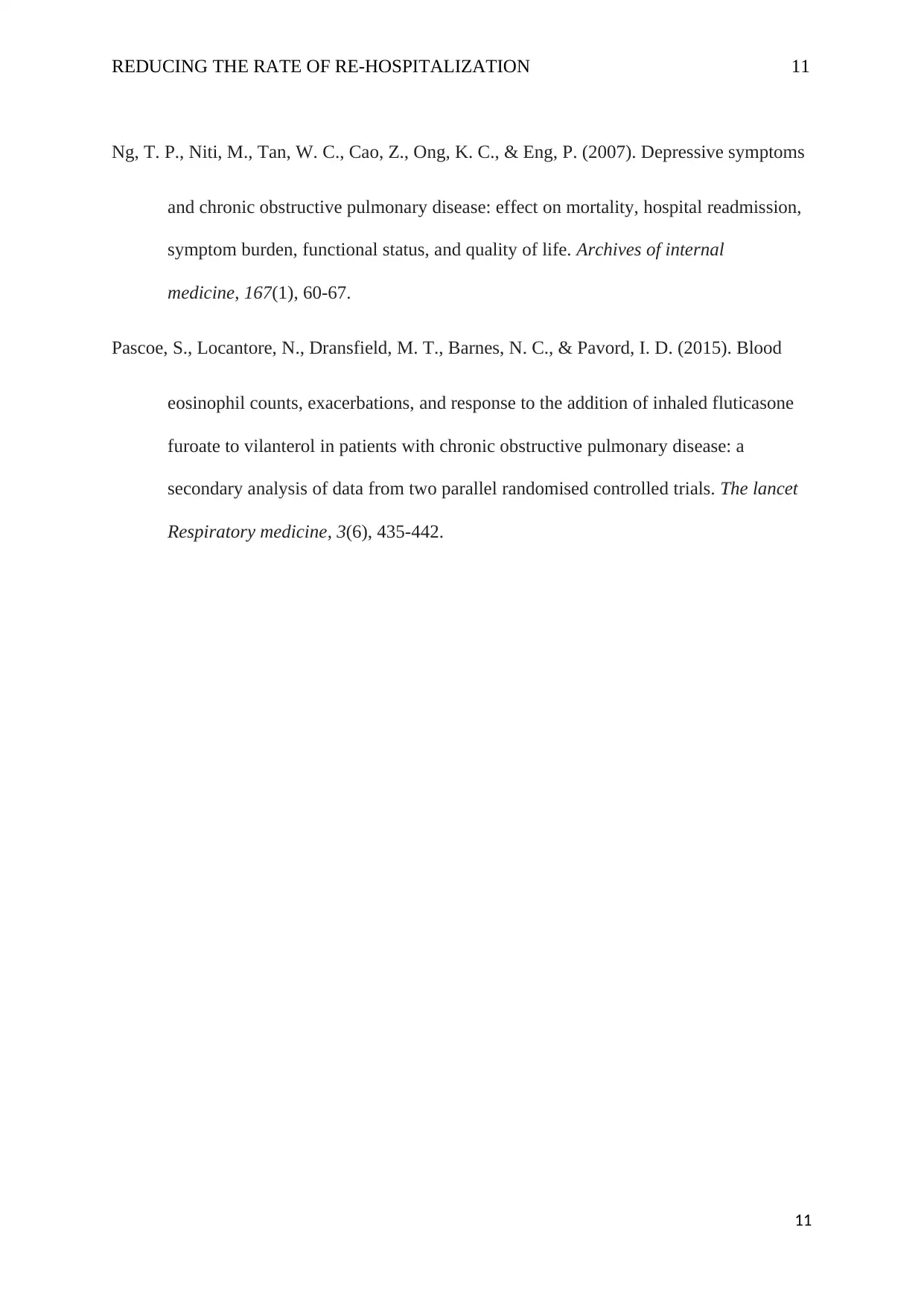
REDUCING THE RATE OF RE-HOSPITALIZATION 11
Ng, T. P., Niti, M., Tan, W. C., Cao, Z., Ong, K. C., & Eng, P. (2007). Depressive symptoms
and chronic obstructive pulmonary disease: effect on mortality, hospital readmission,
symptom burden, functional status, and quality of life. Archives of internal
medicine, 167(1), 60-67.
Pascoe, S., Locantore, N., Dransfield, M. T., Barnes, N. C., & Pavord, I. D. (2015). Blood
eosinophil counts, exacerbations, and response to the addition of inhaled fluticasone
furoate to vilanterol in patients with chronic obstructive pulmonary disease: a
secondary analysis of data from two parallel randomised controlled trials. The lancet
Respiratory medicine, 3(6), 435-442.
11
Ng, T. P., Niti, M., Tan, W. C., Cao, Z., Ong, K. C., & Eng, P. (2007). Depressive symptoms
and chronic obstructive pulmonary disease: effect on mortality, hospital readmission,
symptom burden, functional status, and quality of life. Archives of internal
medicine, 167(1), 60-67.
Pascoe, S., Locantore, N., Dransfield, M. T., Barnes, N. C., & Pavord, I. D. (2015). Blood
eosinophil counts, exacerbations, and response to the addition of inhaled fluticasone
furoate to vilanterol in patients with chronic obstructive pulmonary disease: a
secondary analysis of data from two parallel randomised controlled trials. The lancet
Respiratory medicine, 3(6), 435-442.
11
1 out of 11
Related Documents
Your All-in-One AI-Powered Toolkit for Academic Success.
+13062052269
info@desklib.com
Available 24*7 on WhatsApp / Email
![[object Object]](/_next/static/media/star-bottom.7253800d.svg)
Unlock your academic potential
© 2024 | Zucol Services PVT LTD | All rights reserved.




